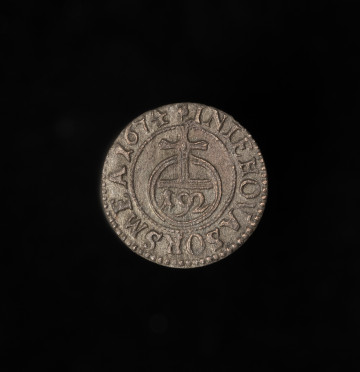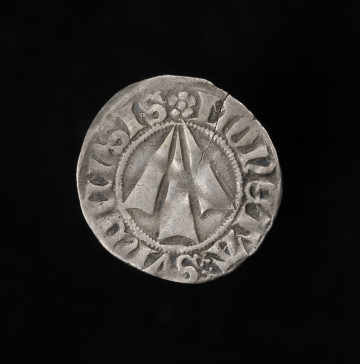
Witten (1/192 of a thaler)
1674
National Museum in Szczecin
Part of the collection: Pomeranian coins
During the reign of King Charles XI (1655–1697), the governor of Swedish Pomerania Count Nils Bielke (1644-1716) had the greatest influence on the Pomeranian minting. With his knowledge and consent, coins inconsistent with the Münzfuß in force were minted in Szczecin. All production between 1689 and 1694 was carried out in secret by Bielke's trusted staff, led by the mintmaster Johann Leonard Arensburg (1665-1719). The illegal profits from minting ended up into personal wallets of several people involved, including the governor and the mintmaster. In 1691–1692, the partners reaped the highest profits from the mass issuance of coin schillings, which at the peak of the fraud contained only 2 lots of silver instead of 6. The actual scale of production was concealed. According to estimates, the combined worth of low-value shillings minted over those two years amounted to approx. 87,000 Reichsthalers. The coins led to large losses in the economy, which most affected the craftsmen purchasing goods abroad and the Swedish soldiers stationed in Pomerania, whose salaries were paid in this currency. In 1697, the provincial government decided to reduce the schillings in circulation. Units containing at least 4 lots of silver were countersigned with a stamp with the crown sign, the remaining ones were devalued by half and exchanged for two-groschen (1/12 of a thaler). Stamping of coins was carried out in four cities: Szczecin, Stralsund, Greifswald and Anklam, and the countersignature was a sign of a good shilling. The Szczecin countermark bore a crown without an additional distinguishing feature, a rosette or a star under the crown was placed in Stralsund, the letter G - in Greiswald, and the letter A in Anklam. Genowefa Horoszko
Other names
schilling
Author / creator
Technique
coining
Material
silver
Origin / acquisition method
acquisition
Creation time / dating
Creation / finding place
Owner
Muzeum Narodowe w Szczecinie
Identification number
Location / status

1674
National Museum in Szczecin

1613
National Museum in Szczecin

1367 — 1380
National Museum in Szczecin
DISCOVER this TOPIC
Museum of King Jan III's Palace at Wilanów
DISCOVER this PATH
Educational path